Apple cider vinegar’s acidic pH of 2.5-3.0 creates an environment fleas can’t tolerate, as they prefer neutral pH conditions for survival. When you apply ACV to your pet’s skin, it alters their natural pH balance, making it difficult for fleas to thrive while disrupting their entire life cycle from eggs to adults. The sour scent also masks odors that typically attract fleas to your pet, acting as a natural repellent that discourages new infestations from establishing themselves on your furry companion.
The Science Behind Apple Cider Vinegar’s Ph Properties
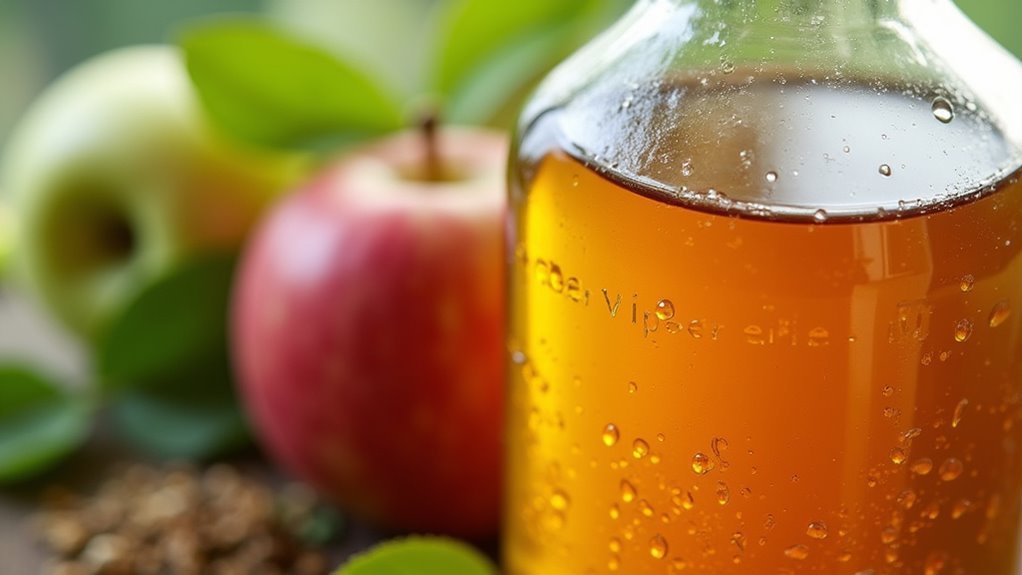
Apple cider vinegar’s acidic nature, with a pH ranging from 2.5 to 3.0, creates an environment that fleas simply can’t tolerate. Your pet’s skin naturally maintains a slightly acidic pH, but when you apply diluted apple cider vinegar, you’re enhancing this protective barrier.
Fleas thrive in neutral pH environments, so this acidity disrupts their comfort zone and survival mechanisms.
The pH properties of apple cider vinegar don’t just repel adult fleas – they interfere with the entire flea life cycle. This natural repellent makes it difficult for eggs to develop and larvae to mature.
While it won’t eliminate severe infestations alone, incorporating apple cider vinegar into your pet health routine creates an inhospitable environment that supports your overall flea control strategy without harsh chemicals.
How Acidic Environments Repel Fleas Naturally
When fleas encounter the acidic environment created by apple cider vinegar, their natural survival instincts kick in to find more suitable conditions.
You’re fundamentally disrupting their preferred neutral to slightly alkaline habitat on your pet’s skin. Fleas have a specific pH preference that supports their survival, and ACV’s acidity works against this biological need.
The sour scent also masks the attractive odors that typically draw fleas to your pet.
While apple cider vinegar won’t kill existing fleas, it creates unfavorable conditions that repel fleas and discourage new infestations.
By altering the skin’s pH balance, you’re making flea establishment considerably more difficult.
This natural approach targets their environmental preferences rather than using harsh chemicals to eliminate them.
Apple Cider Vinegar’s Impact on Flea Life Cycles
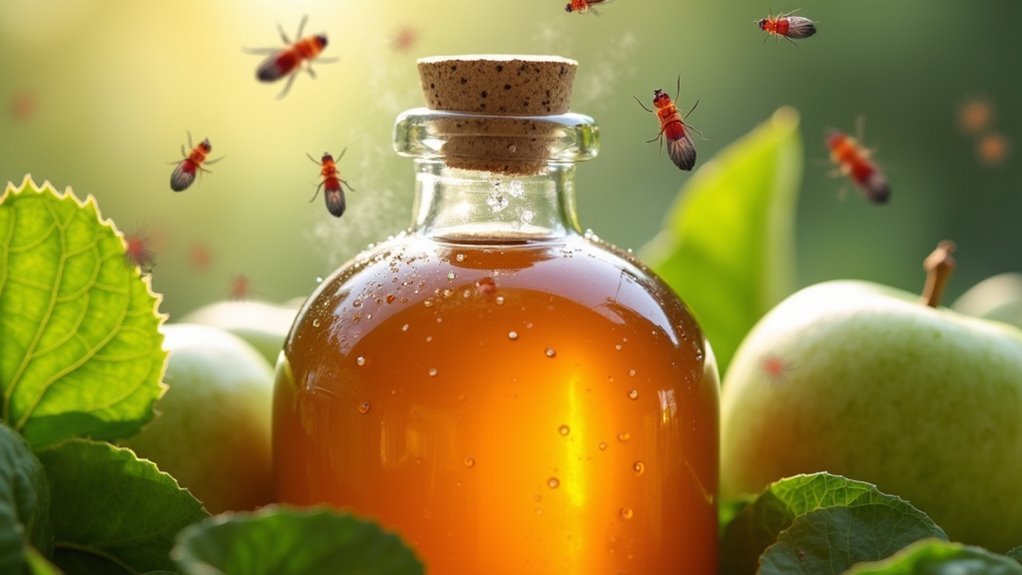
You’ll find that apple cider vinegar’s strongest effect targets adult fleas through its repellent properties, making it harder for them to locate and feed on your pet.
However, ACV has limited ability to disrupt flea eggs once they’re laid, since these eggs don’t rely on the host’s skin environment for survival.
This means you’re dealing with incomplete life cycle control, as ACV won’t eliminate the next generation of fleas developing in your carpets and bedding.
ACV Repels Adult Fleas
Although apple cider vinegar won’t kill fleas outright, it can effectively repel adult fleas through its strong odor and acidic properties that these pests find particularly unpleasant.
When you apply apple cider vinegar to your pet’s skin, its acidic nature alters the pH levels, creating an environment that’s less hospitable for fleas. This makes it harder for them to thrive and reproduce on your pet.
The sour taste and pungent smell act as natural deterrents, causing adult fleas to seek more appealing hosts elsewhere.
However, you shouldn’t rely solely on ACV for complete flea elimination. Instead, incorporate it into a thorough flea control strategy alongside traditional flea treatments for best results against persistent infestations.
Limited Egg Disruption Effects
While ACV shows promise in repelling adult fleas, it falls short when it comes to disrupting the flea life cycle at its most vulnerable stages.
Apple cider vinegar primarily acts as a repellent rather than a lethal treatment, meaning it won’t effectively target flea eggs or larvae hiding in your carpets and furniture.
Here’s why ACV has limited effectiveness against flea reproduction:
- Eggs remain unaffected – The acidic properties don’t penetrate or damage flea eggs considerably.
- Larvae continue developing – Young fleas in carpeting aren’t exposed to sufficient concentrations to halt growth.
- Rapid reproduction continues – Without killing eggs, you’re facing up to 50 new eggs daily per adult flea.
A serious flea infestation requires extensive flea treatments that specifically target all life cycle stages, not just adult repelling methods.
Incomplete Life Cycle Control
The broader issue extends beyond just eggs and larvae—apple cider vinegar can’t effectively control any stage of the flea life cycle. You’ll find that Apple Cider Vinegar Kill rates remain consistently low across all developmental phases, creating incomplete control that allows flea infestations to persist indefinitely.
| Life Stage | ACV Effectiveness | Result |
|---|---|---|
| Eggs | Minimal | Continued hatching |
| Larvae | Poor | Ongoing development |
| Pupae | None | Normal emergence |
| Adults | Repellent only | Temporary displacement |
| Population | Insufficient | Sustained infestation |
While natural methods appeal to many pet owners, the flea life cycle spanning several weeks requires targeted intervention at every stage. Without addressing reproductive cycles and developmental phases, you’re fundamentally treating symptoms rather than causes, ensuring effective flea control remains elusive regardless of application frequency.
Creating an Effective ACV Flea Bath Solution
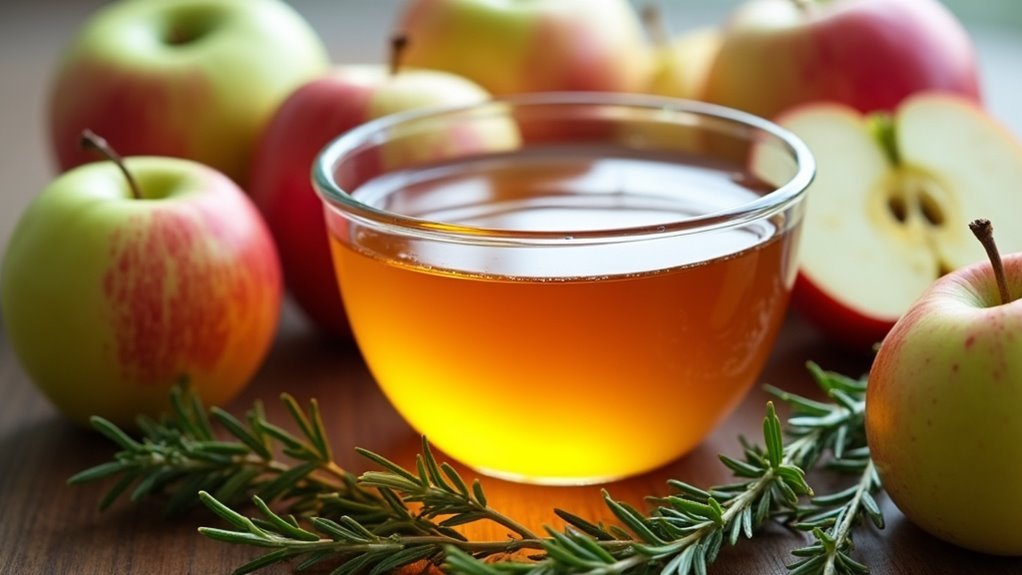
You’ll need to get the ACV-to-water ratio right and follow proper application steps to create a flea bath that’s both effective and safe for your pet.
The mixing proportions and how you apply the solution directly impact whether you’ll successfully repel fleas without harming your furry friend.
Let’s cover the essential ratios and safety steps that’ll make your ACV flea bath work properly.
Proper ACV Bath Ratios
Creating an effective ACV flea bath starts with getting the ratio right, and most pet owners find success with a simple 1:1 mixture of apple cider vinegar to water. This balanced approach helps maintain your pet’s skin pH while maximizing flea-deterrent properties.
Here’s your proper mixing guide:
- Basic ratio: Mix 1 cup apple cider vinegar with 1 cup water for standard treatment.
- Enhanced solution: Add 2-3 drops of natural essential oils like lavender (dogs only – avoid for cats).
- Application time: Let the solution sit for 10 minutes before thorough rinsing.
You can adjust quantities based on your pet’s size and flea severity.
Always rinse completely to prevent skin irritation, and keep the solution away from eyes and ears during your flea bath routine.
Application and Safety Steps
Knowing your ratios sets the foundation, but proper application technique makes all the difference in your ACV flea bath’s effectiveness.
Begin by thoroughly wetting your pet’s fur with warm water to guarantee even distribution. Apply the apple cider vinegar mixture directly to the coat, massaging it into the skin for complete coverage. Let the solution sit for ten minutes to maximize flea-repelling benefits.
During application, focus on safety by avoiding your pet’s eyes and ears.
After the waiting period, rinse thoroughly with warm water, removing all residue. Monitor your pet closely for signs of skin irritation or adverse reactions. If discomfort occurs, discontinue use immediately and consult your veterinarian for guidance.
Step-by-Step Guide to Preparing Your Pet’s Vinegar Bath
Five simple steps will transform your regular bathing routine into an effective flea treatment using apple cider vinegar. This natural approach helps remove fleas while being gentler than chemical alternatives.
Apple cider vinegar offers a gentle, natural alternative to harsh chemical flea treatments for your beloved pets.
Here’s your complete preparation guide:
- Mix the solution – Combine equal parts apple cider vinegar and water in a bucket, ensuring you have enough bath water to thoroughly cover your pet’s fur.
- Pre-treatment preparation – Brush your pet’s coat to remove loose fleas and debris before starting the bathing process.
- Application process – Wet your pet with warm water, then pour the solution over their body, avoiding eyes and ears, and let it sit for 10 minutes before you rinse completely.
Proper Application Techniques for Maximum Results
Getting your application technique right makes the difference between a mediocre flea treatment and complete success. When using your apple cider vinegar flea spray, these proper application techniques guarantee maximum results.
Wear gloves and long-sleeved clothing to protect yourself from potential flea bites during treatment. Apply the solution directly to your pet’s fur, guaranteeing thorough coverage of their entire coat.
Don’t rush the process – let the mixture sit for at least ten minutes before rinsing. This waiting period allows the vinegar to effectively repel and eliminate fleas.
After rinsing, use a flea comb to remove dead fleas and eggs. Monitor your pet closely for any signs of skin irritation, adjusting treatment frequency based on their individual response to maintain their comfort.
Safety Considerations When Using Apple Cider Vinegar on Pets
While apple cider vinegar offers a natural approach to flea control, you must understand the potential risks before applying it to your pet. Though ACV is non-toxic, it can still cause significant gastrointestinal issues if your pet ingests it, resulting in vomiting and diarrhea.
Key safety considerations include:
- Topical application risks – ACV can cause serious skin irritation, especially in pets with sensitive skin, prompting them to lick the treated area.
- Ear application dangers – Never apply ACV to your pet’s ears, as it dries out the canal and worsens infections.
- Professional guidance – Always seek veterinary consultation before using ACV to verify it’s appropriate for your individual pet.
High-quality commercial flea preventatives remain more effective with fewer adverse effects.
Signs Your Pet May Be Sensitive to Vinegar Treatments
Even with proper precautions, your pet may still develop sensitivity to vinegar treatments that requires immediate attention.
Watch for excessive scratching, which indicates skin irritation or discomfort from the vinegar application. Redness, swelling, or sores appearing on your pet’s skin signal an adverse reaction that demands immediate treatment discontinuation.
Gastrointestinal issues like vomiting or diarrhea may occur if your pet ingests vinegar during grooming or treatment.
Pets with existing skin conditions or allergies face higher risks of developing negative reactions to vinegar-based flea treatments.
You must monitor your pet closely for unusual behavior or physical changes after introducing any vinegar treatment.
If you suspect sensitivity, contact your veterinarian immediately for professional guidance and alternative flea control options.
Combining ACV Baths With Other Natural Flea Control Methods
Although ACV baths offer effective flea control on their own, you’ll achieve superior results by combining them with complementary natural flea control methods that target fleas at different life stages.
Adding essential oils like lavender or lemon to your apple cider vinegar bath enhances the repellent effects without harsh chemicals.
After bathing, use a fine-tooth flea comb to remove remaining fleas and eggs while your pet’s coat is still damp.
Create a thorough flea management system by implementing these strategies:
- Weekly ACV baths with proper dilution (1:3 ratio) followed by thorough combing
- Regular cleaning including frequent vacuuming and washing pet bedding in hot water
- Yard treatment with diatomaceous earth to eliminate fleas in outdoor environments
This multi-pronged approach targets fleas throughout their entire life cycle for maximum effectiveness.
How Often to Administer Apple Cider Vinegar Baths
Most pet owners should administer apple cider vinegar baths once weekly to maintain effective flea control without overwhelming their pet’s skin.
This frequency allows the acidic solution to balance your pet’s skin pH and deter fleas while minimizing risk of skin irritation from overexposure.
You’ll want to monitor your pet carefully after each bathing session, especially during initial treatments.
If you notice any adverse reactions, reduce the frequency or discontinue use.
Remember that apple cider vinegar baths shouldn’t be your only defense against fleas.
You’ll achieve better results by combining weekly ACV baths with other methods like flea combing and topical treatment applications.
This thorough approach guarantees complete flea prevention while keeping your pet comfortable and healthy throughout the treatment process.
Treating Your Home Environment With Vinegar Solutions
You’ll need to extend your flea control efforts beyond bathing your pet to include treating your entire home environment with ACV solutions.
Start by creating floor cleaning mixtures that can eliminate flea eggs and larvae from hard surfaces throughout your house.
You should also focus on treating carpets, furniture, and washing all pet bedding areas where fleas commonly hide and reproduce.
ACV Floor Cleaning Solutions
When fleas invade your home, they don’t just stay on your pets—they spread throughout your living spaces, laying eggs in carpets, furniture, and floor crevices where they can quickly multiply.
An ACV floor cleaning solution becomes your weapon against this infestation. Mix equal parts apple cider vinegar and water to create an effective cleaning solution that eliminates flea eggs while deodorizing surfaces.
Here’s how to maximize your cleaning efforts:
- Focus on pet areas – Clean floors where your pets spend most time, ensuring thorough coverage of corners and crevices.
- Add dish soap – Combine ACV with dish soap to trap adult fleas more effectively.
- Maintain consistency – Use this cleaning solution regularly alongside vacuuming and washing pet bedding for best results.
Carpet and Furniture Treatment
Beyond floor surfaces, carpets and upholstered furniture require targeted attention since these soft surfaces trap flea eggs and provide ideal breeding conditions.
You can create an effective apple cider vinegar cleaning solution by mixing equal parts ACV and water in a spray bottle. This mixture helps repel fleas due to vinegar’s strong odor that pests find offensive. Spray the solution directly onto carpets and furniture where fleas may be present.
However, always test a small, inconspicuous area first to prevent fabric damage. Regular application disrupts the flea life cycle by deterring adults and potentially preventing eggs from hatching.
For maximum results, combine ACV treatments with thorough vacuuming and washing pet bedding to eliminate existing fleas.
Washing Pet Bedding Areas
While carpets and furniture harbor many fleas, your pet’s bedding areas serve as the primary breeding grounds where these pests lay eggs and multiply rapidly.
You’ll need to focus your efforts on washing pet bedding thoroughly to eliminate flea populations at their source.
Here’s your three-step approach for treating bedding areas:
- Wash everything in hot, soapy water – Use high heat settings to kill flea eggs and larvae hiding in fabric fibers.
- Apply vinegar solution to surrounding surfaces – Mix equal parts water and apple cider vinegar to clean nearby floors and walls.
- Establish regular cleaning routines – Wash bedding weekly and maintain vinegar treatments to eliminate flea reinfestation.
This targeted approach disrupts the flea life cycle where it matters most.
Monitoring Treatment Progress and Effectiveness
Three key indicators will help you determine whether your apple cider vinegar treatment is working effectively against fleas. First, monitor your pet for signs of skin irritation or adverse reactions, as some animals show sensitivity to ACV solutions. Second, regularly check for fleas and flea dirt in your pet’s fur to assess treatment effectiveness. Third, observe behavioral changes like reduced scratching that indicate improved comfort.
| Monitoring Method | What to Look For |
|---|---|
| Visual Inspection | Black specks (flea dirt) in fur |
| Flea Combing | Number of live fleas removed |
| Skin Assessment | Redness, irritation, or sensitivity |
| Behavior Tracking | Scratching frequency and discomfort |
Keep a detailed log of flea combing sessions to track removal numbers over time. If you don’t see significant improvement within several weeks, reassess treatment frequency and combine ACV with other flea control methods.
When to Transition From Natural to Veterinary Treatments
Although apple cider vinegar can be effective for mild flea problems, you’ll need to recognize when it’s time to seek professional veterinary treatment.
Natural remedies have limitations, and persistent flea infestations require stronger intervention to protect your pet’s health.
Consider shifting to veterinary treatments when:
- Persistent infestations – If fleas continue appearing after weeks of consistent natural flea treatment, you’re likely dealing with severe infestation or increased resistance.
- Health complications – When your pet shows excessive scratching, skin irritation, lethargy, weight loss, or pale gums despite natural remedies.
- Unbroken flea cycles – Frequent re-infestations or visible flea eggs indicate natural methods aren’t disrupting the reproductive cycle effectively.
Don’t hesitate to consult a veterinarian for tailored solutions and prescription medications that can provide more thorough flea control.
Frequently Asked Questions
How Long Does It Take Apple Cider Vinegar to Kill Fleas?
Apple cider vinegar doesn’t actually kill fleas—it only repels them temporarily. You’ll need to reapply it every few hours since its effects fade quickly and won’t eliminate the underlying infestation completely.
What Kills Fleas on Dogs Instantly With Apple Cider Vinegar?
You can’t kill fleas instantly on your dog with apple cider vinegar. It doesn’t have insecticidal properties and only acts as a mild deterrent. You’ll need veterinarian-recommended flea treatments for immediate elimination.
What Is the Best Homemade Flea Killer?
You’ll get best results mixing equal parts water and apple cider vinegar with a few drops of Castile soap. Add lemon juice and witch hazel for extra power against stubborn flea infestations.
Why Do Fleas Hate Apple Cider Vinegar?
You’ll find fleas hate apple cider vinegar because its strong, sour smell repels them. The acidic nature disrupts their preferred pH environment, while the unpalatable taste makes treated pets unattractive hosts for infestation.
In Summary
You’ve learned how apple cider vinegar’s acidic pH disrupts fleas’ preferred alkaline environment, making your pet less appealing to these pests. By creating proper ACV bath solutions and treating your home environment, you’re attacking fleas at multiple life stages. Remember to monitor your pet’s response and don’t hesitate to consult your veterinarian if the infestation persists. While ACV can be effective, severe flea problems may require professional treatment for complete elimination.

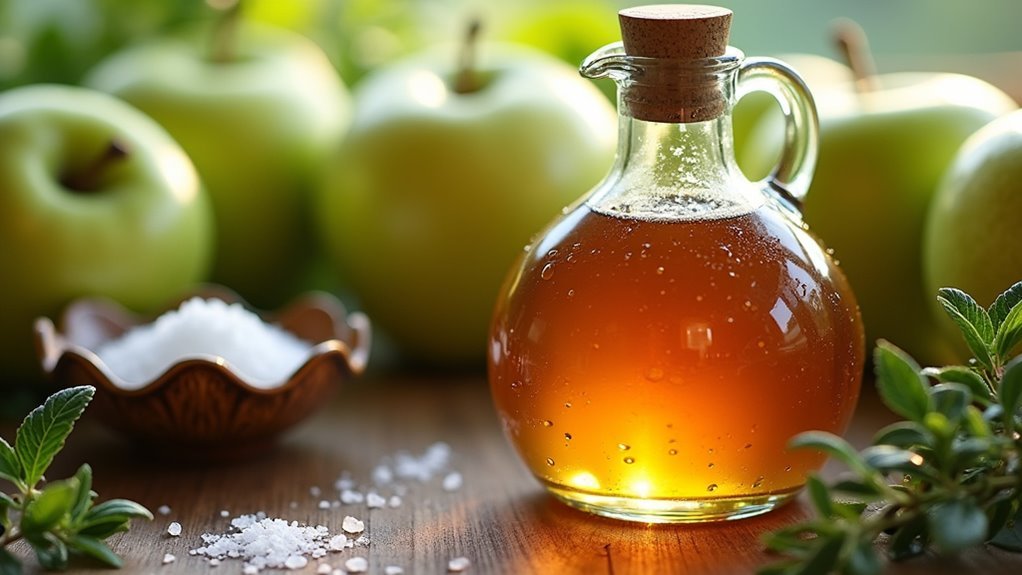
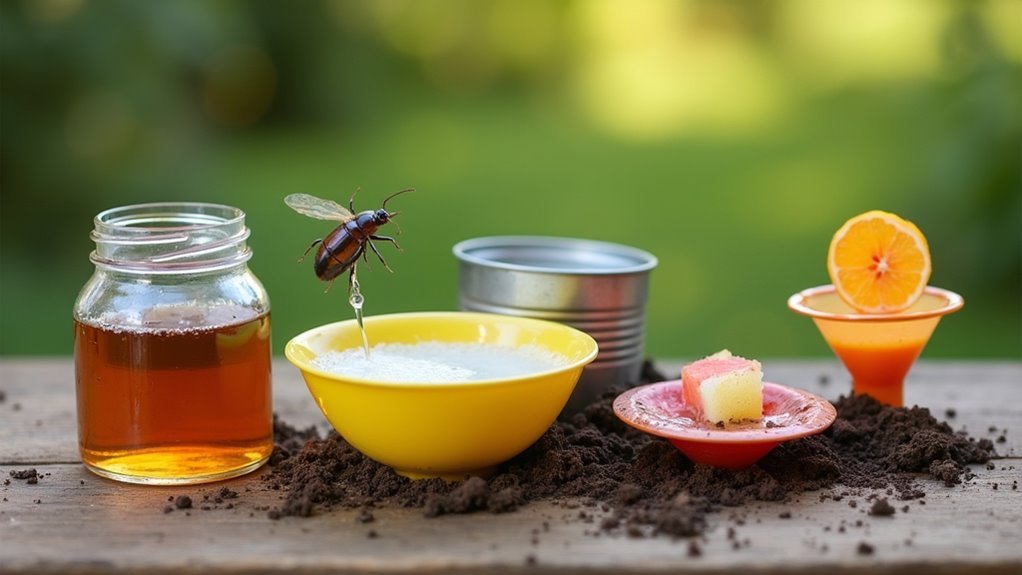
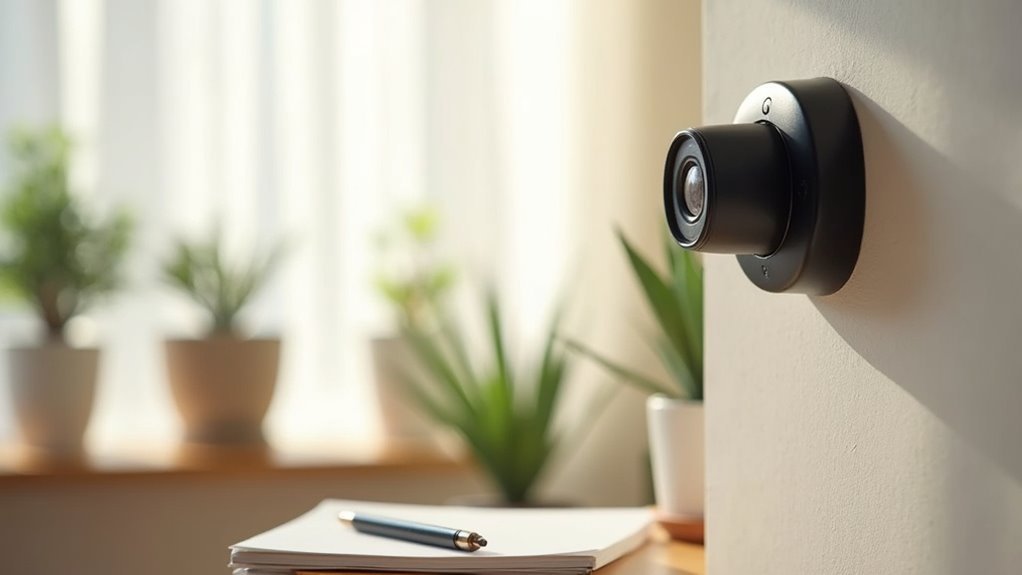
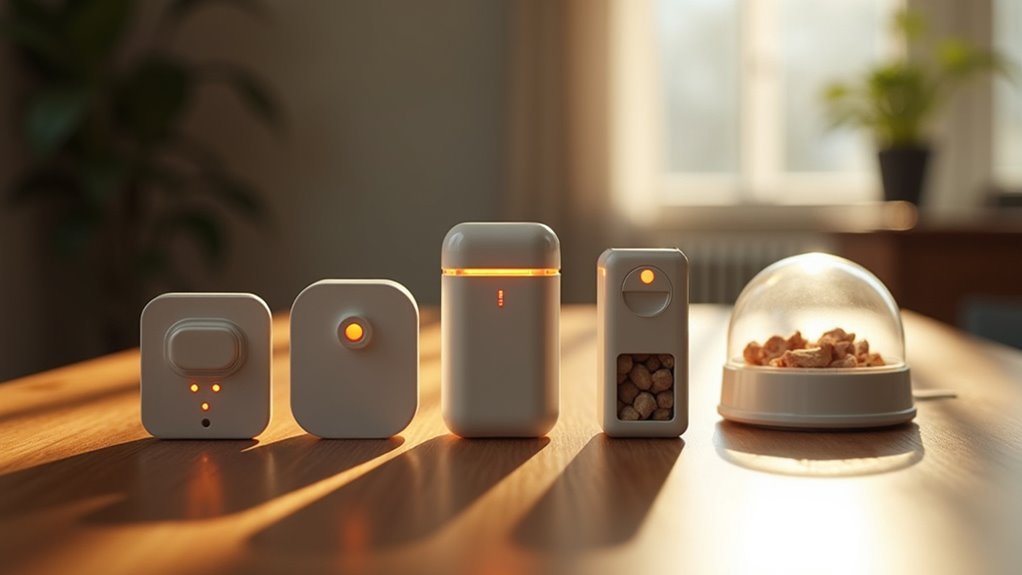
Leave a Reply